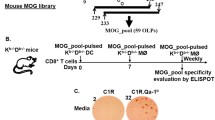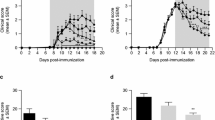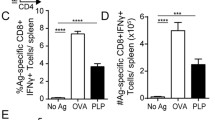Abstract
In the current study, we present an innovative concept based on the knowledge that enhancing naturally occurring biological mechanisms is effective in preventing neuronal damage and maintaining low disease activity in about 15% of multiple sclerosis (MS) patients presenting the benign type of MS. Recently, we have demonstrated that low disease activity in benign MS is associated with suppression of RNA polymerase 1 (POL1) pathway; therefore, targeting POL1 transcription machinery as a strategy for suppressing active forms of MS is suggested. To further establish our approach, we aimed to suppress POL1 pathway by silencing of the POL1-related RRN3, POLR1D and LRPPRC genes in specific MOG35-55-activated lymphocytes and assess their capacity to induce experimental autoimmune encephalomyelitis (EAE) by passive transfer. We have demonstrated that silencing of specific POL1 pathway-related genes significantly decreased viability and increased the proportion of CD4+/AnnexinV+/PI+ apoptotic cells in MOG35-55-primed lymphocytes. POL1-gene silencing significantly decreased the proportion of CD4+IL17+ and increased proportion of CD4+IL10+ and CD4+TNFa+ lymphocytes that occurred simultaneously with over-presentation of Treg CD4+CD25+FoxP3+ cells. Passive transfer of MOG35-55-primed lymphocytes after POL1-gene silencing suppressed EAE development in mice as demonstrated by delayed onset and peak of disease accompanied by significantly lower maximal and cumulative EAE scores. Our study supports a basis for direct targeting of POL1 transcription pathway as a strategy for selective induction of apoptosis and suppression of inflammation in EAE and consequently paves the way for innovative and targeted MS therapeutic strategy that is based on naturally existing biological mechanism.






Similar content being viewed by others
Abbreviations
- POL1:
-
Polymerase 1
- EAE:
-
Experimental autoimmune encephalomyelitis
- MS:
-
Multiple sclerosis
- RRN3:
-
RNA polymerase I transcription factor 3
- POLR1D:
-
RNA polymerase I polypeptide D
- TNFa:
-
Tumor necrosis factor alpha
- IL-10:
-
Interleukin 10
- IL-4:
-
Interleukin 4
- IL-17:
-
Interleukin 17
- MOG:
-
Myelin oligodendrocyte glycoprotein
- FoxP3:
-
Forkhead box P3
References
Achiron, A., Feldman, A., Magalashvili, D., Dolev, M., & Gurevich, M. (2012). Suppressed RNA-polymerase 1 pathway is associated with benign multiple sclerosis. PLoS ONE, 7(10), e46871. doi:10.1371/journal.
Achiron, A., Mashiach, R., Zilkha-Falb, R., Meijler, M. M., & Gurevich, M. (2013). Polymerase I pathway inhibitor ameliorates experimental autoimmune encephalomyelitis. Journal of Neuroimmunology, 263(1–2), 91–97.
Achiron, A., Polliack, M., Rao, S. M., Barak, Y., Lavie, M., Appelboim, N., et al. (2005). Cognitive patterns and progression in multiple sclerosis: Construction and validation of percentile curves. Journal of Neurology, Neurosurgery and Psychiatry, 76(5), 744–749.
Achiron, A., Zilkha-Falb, R., Mashiach, R., & Gurevich, M. (2017). RAM-589.555 a new Polymerase-1 inhibitor as innovative targeted-treatment for multiple sclerosis. Journal of Neuroimmunology, 302, 41–48.
Compston, A., & Coles, A. (2008). Multiple sclerosis. Lancet, 372(9648), 1502–1517.
Confavreux, C., & Vukusic, S. (2008). The clinical epidemiology of multiple sclerosis. Neuroimaging Clinics of North America, 18(4), 589–622.
Donati, G., Bertoni, S., Brighenti, E., Vici, M., Trere, D., Volarevic, S., et al. (2011). The balance between rRNA and ribosomal protein synthesis up- and downregulates the tumour suppressor p53 in mammalian cells. Oncogene, 30(29), 3274–3288.
Glad, S. B., Nyland, H. I., Aarseth, J. H., Riise, T., & Myhr, K. M. (2009). Long-term follow-up of benign multiple sclerosis in Hordaland County. Western Norway. Multiple Sclerosis, 15(8), 942–950.
Golomb, L., Volarevic, S., & Oren, M. (2014). p53 and ribosome biogenesis stress: the essentials. FEBS Letters, 588(16), 2571–2579.
Goodfellow, S. J., & Zomerdijk, J. C. (2013). Basic mechanisms in RNA polymerase I transcription of the ribosomal RNA genes. Sub-Cellular Biochemistry, 61, 211–236.
Hawkins, S. A., & McDonnell, G. V. (1999). Benign multiple sclerosis? Clinical course, long term follow up, and assessment of prognostic factors. Journal of Neurology, Neurosurgery and Psychiatry, 67(2), 148–152.
Kruglov, A. A., Lampropoulou, V., Fillatreau, S., & Nedospasov, S. A. (2011). Pathogenic and protective functions of TNF in neuroinflammation are defined by its expression in T lymphocytes and myeloid cells. Journal of Immunology, 187(11), 5660–5670.
Moon, Y. (2014). Ribosomal alteration-derived signals for cytokine induction in mucosal and systemic inflammation: noncanonical pathways by ribosomal inactivation. Mediators of Inflammation, 2014, 708193.
Pittock, S. J., & Rodriguez, M. (2008). Benign multiple sclerosis: a distinct clinical entity with therapeutic implications. Current Topics in Microbiology and Immunology, 318, 1–17.
Poser, S., Wikstrom, J., & Bauer, H. J. (1979). Clinical data and the identification of special forms of multiple sclerosis in 1271 cases studied with a standardized documentation system. Journal of the Neurological Sciences, 40(2–3), 159–168.
Ramsaransing, G. S., & De Keyser, J. (2007). Predictive value of clinical characteristics for ‘benign’ multiple sclerosis. European Journal of Neurology, 14(8), 885–889.
Stepanchick, A., Zhi, H., Cavanaugh, A. H., Rothblum, K., Schneider, D. A., & Rothblum, L. I. (2013). DNA binding by the ribosomal DNA transcription factor rrn3 is essential for ribosomal DNA transcription. Journal of Biological Chemistry, 288(13), 9135–9144.
Yuan, X., Zhou, Y., Casanova, E., Chai, M., Kiss, E., Grone, H. J., et al. (2005). Genetic inactivation of the transcription factor TIF-IA leads to nucleolar disruption, cell cycle arrest, and p53-mediated apoptosis. Molecular Cell, 19(1), 77–87.
Funding
This work was supported by National Network of Excellence in Neuroscience—Israel (NNE)—2014.
Author information
Authors and Affiliations
Corresponding author
Ethics declarations
Conflict of interest
The authors have no financial or other relationship that may be perceived as a conflict of interest.
Electronic Supplementary Material
Below is the link to the electronic supplementary material.
Rights and permissions
About this article
Cite this article
Zilkha-Falb, R., Gurevich, M. & Achiron, A. Experimental Autoimmune Encephalomyelitis Ameliorated by Passive Transfer of Polymerase 1-Silenced MOG35-55 Lymphatic Node Cells: Verification of a Novel Therapeutic Approach in Multiple Sclerosis. Neuromol Med 19, 406–412 (2017). https://doi.org/10.1007/s12017-017-8456-8
Received:
Accepted:
Published:
Issue Date:
DOI: https://doi.org/10.1007/s12017-017-8456-8




